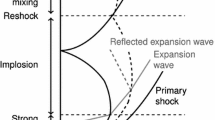Abstract
The head-on collision of a combustion front with a closely packed bed of ceramic-oxide spheres was investigated in a vertical 76.2 mm diameter tube containing a nitrogen diluted stoichiometric ethylene–oxygen mixture. A layer of spherical beads in the diameter range of 3–12.7 mm was placed at the bottom of the tube and a flame was ignited at the top endplate. Four orifice plates spaced at one tube diameter were placed at the ignition end of the tube in order to accelerate the flame to either a “fast-flame” or a detonation wave before the bead layer face. The mixture reactivity was adjusted by varying the initial mixture pressure between 10 and 100 kPa absolute. The pressure before and within the bead layer was measured by flush wall-mounted pressure transducers. For initial pressures where a fast-flame interacts with the bead layer peak pressures recorded at the bead layer face were as high as five times the reflected Chapman–Jouget detonation pressure. The explosion resulting from the interaction developed by two distinct mechanisms; one due to the shock reflection off the bead layer face, and the other due to shock transmission and mixing of burned and unburned gas inside the bead layer. The measured explosion delay time (time after shock reflection from the bead layer face) was found to be independent of the incident shock velocity. As a result, the explosion initiation is not the direct result of the shock reflection process but instead is more likely due to the interaction of the reflected shock wave and the trailing flame. The bead layer was found to be very effective in attenuating the explosion front transmitted through the bead layer and thus isolating the tube endplate.
Similar content being viewed by others
References
Bartknecht W. (1981). Explosion: Course, Prevention, Protection. Springer, Berlin
di Mare L., Mihalik T.A., Continillo G. and Lee J.H. (2000). Experimental and numerical study of flammability limits of gaseous mixtures in porous media. Exp. Therm. Fluid Sci. 21(1–3): 117–123
Joo P., Duncan K. and Ciccarelli G. (2006). Flame quenching performance of ceramic foam. Combust. Sci. Technol. 178(10–11): 1755
Spalding D.B. (1957). A theory of flammability limits and flame quenching. Proc. R. Soc. Lond. A 240(1220): 83–100
Babkin V.S., Korzhavin A.A. and Bunev V.A. (1991). Propagation of premixed gaseous explosion flames in porous media. Combust. Flame 87: 182–190
Pinaev A.V. (1994). Combustion modes and flame propagation criteria for an encumbered space. Combust. Explos. Shock Waves 30(4): 454–461
Makris A., Shafique H., Lee J.H. and Knystautas R. (1995). Influence of mixture sensitivity and pore size on detonation velocities in porous media. Shock Waves 5: 89–95
Slungaard T., Engebretson T. and Sonju O.K. (2003). The influence of detonation cell size and regularity on the propagation of gaseous detonations in granular materials. Shock Waves 12: 301–308
Gvozdeeva L.G., Faresov I.M., Brossard J. and Charpentier N. (1986). Normal shock wave reflection on porous compressible materials. AIAA Prog. Astronaut. Aeronaut. 106: 155–165
Skews B.W. (1991). The reflected pressure field in the interaction of weak shock waves with compressible foam. Shock Waves 1: 205–211
Mazor G., Ben-Dor G., Igra O. and Sorek S. (1994). Shock wave interaction with cellular materials. Shock Waves 3: 159–165
Levy A., Ben-Dor G., Skews B.W. and Sorek S. (1993). Head-on collision of normal shock waves with rigid porous materials. Exp. Fluids 15: 183–190
Strelow R.A. and Cohen A. (1959). Limitations of the reflected shock technique for studying fast chemical reactions and its application to the observation of relaxation in nitrogen and oxygen. J. Chem. Phys. 10(1): 257–265
Peraldi O., Knystautas R. and Lee J.H. (1986). Criteria for transition to detonation in tubes. Proc. Combust. Inst. 21: 1629–1637
Shepherd J.: Detonation data base. http://www.galcit.caltech.edu/detn_db/html/
Ciccarelli G., Fowler C. and Bardon M. (2005). Effects of obstacle size and spacing on the initial stage of flame acceleration in a rough tube. Shock Waves 14(3): 161–166
Scarinci T., Lee J.H., Thomas G.O., Bambrey R.J. and Edwards D.H. (1993). Amplification of a pressure wave due to its passage through a flame. AIAA Prog. Astronauti. 152: 3–24
Shepherd, J.E.: http://www.galcit.caltech.edu/EDL/public/sdt/SD_Toolbox/
Konnov, A.A.: Detailed reaction mechanism for small hydrocarbons combustion. Release 0.4, http://homepages.vub.ac.be/konnov/ (1998)
Author information
Authors and Affiliations
Corresponding author
Additional information
Communicated by L. Bauwens.
Rights and permissions
About this article
Cite this article
Hlouschko, S., Ciccarelli, G. Interaction of a high-speed combustion front with a closely packed bed of spheres. Shock Waves 18, 317–327 (2008). https://doi.org/10.1007/s00193-008-0132-3
Received:
Revised:
Accepted:
Published:
Issue Date:
DOI: https://doi.org/10.1007/s00193-008-0132-3




